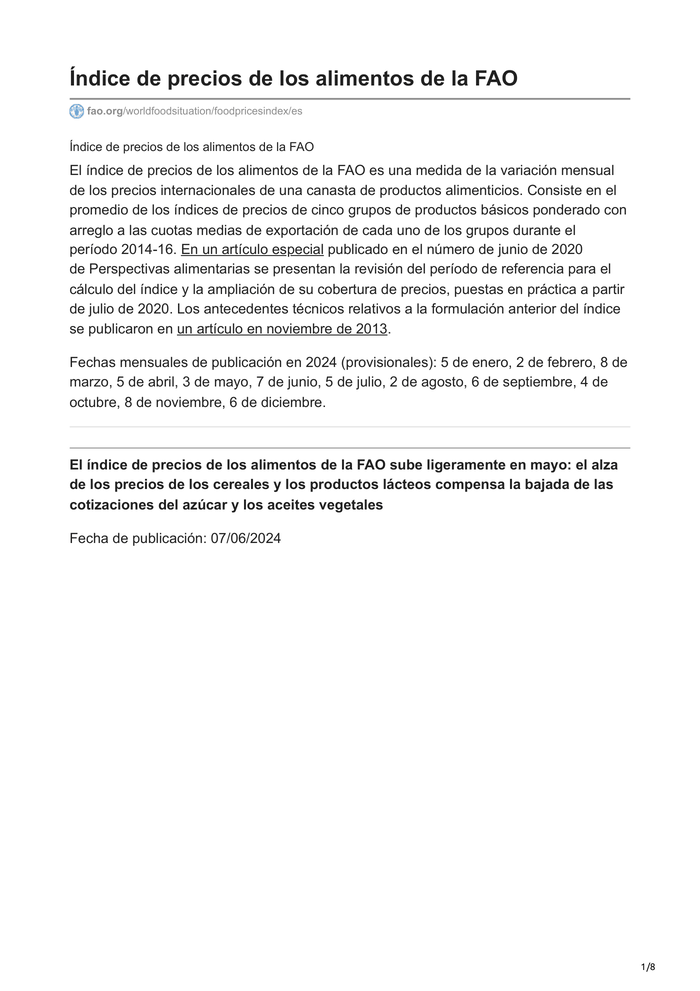” He FAO food price index* stood at 120.4 points in May 2024, that is, 1.1 points (0.9%) above its revised level in April, as increases in the price indices of cereals and Dairy products almost more than offset declines in sugar and vegetable oil prices, while the meat price index remained virtually unchanged. Although the index registered a third consecutive monthly rally in May, it remained 3.4% below its corresponding value a year ago and 24.9% below the maximum of 160.2 points reached in March 2022.
” He FAO cereal price index registered an average of 118.7 points in May, that is, 7.1 points (6.3%) more than in April, but it is still 10.6 points (8.2%) below the value recorded in May 2023. World prices of all major export cereals rose from the previous month, with wheat rising the most. The sharp monthly rise was largely due to growing concerns about unfavorable growing conditions affecting the 2024 crops, possibly limiting yields in some of the main producing areas of several major exporting countries, particularly parts from Europe, North America and the Black Sea region. Furthermore, damage to shipping infrastructure in the Black Sea aggravated upward pressure on prices. Corn prices for export also increased in May, as a result of concerns about production in both Argentina (due to crop damage due to the spread of the disease caused by Spiroplasma kunkelii) as in Brazil (due to unfavorable atmospheric conditions), together with the low sales activity of farmers in Ukraine, in a context of seasonal reduction in supply and strong global demand. Indirect effects from wheat markets were also reflected in corn prices. As for other coarse grains, world prices for barley and sorghum also rose in May. The FAO price index for all types of rice evolved upwards in May, by 1.3%, under the influence of sales expectations to Brazil and Indonesia and as the impact of the harvest eased.
” He FAO vegetable oil price index It stood at an average of 127.8 points in May, which represents a month-on-month decrease of 3.1 points (2.4%), although it is 7.7% above its level a year ago. The decline in the index was mainly due to the drop in palm oil prices, which more than offset the increase in soybean, rapeseed and sunflower prices. International palm oil prices declined for the second consecutive month in May, as seasonal production increased in major producing countries in Southeast Asia amid prolonged weakness in global import demand. In contrast, global soybean oil prices rebounded in May, generally supported by growing demand from the biofuels sector, particularly in Brazil. For their part, sunflower and rapeseed oil prices also rose, mainly due to the seasonal decrease in exportable availabilities in the Black Sea region and the probability of greater supply shortages in the next 2024/25 campaign. , respectively.
” He FAO Dairy Price Index registered an average of 126.0 points in May, that is, 2.3 points (1.8%) more than in April, which contributed to increasing the value of the index by 4.3 points (3.5% ) above its value a year ago. In May, international prices for all dairy products represented in the index rose. The increase in dairy product prices in May was driven by increased demand from the retail and food service sectors due to the summer holidays and market expectations that milk production may fall below the lowest levels of all time in Western Europe, coupled with the seasonal decline in milk production in Oceania. In addition, the resumption of import demand for spot supplies, especially in some countries in the Near East and North Africa, contributed to the rise in dairy product prices.
” He FAO meat price index* registered an average of 116.6 points in May, that is, just 0.2 points (0.2%) less than in April, and was 1.5 points (1.3%) below its value from a year ago. International prices for poultry and beef meat fell, while those for pork and sheep rose. The fall in world poultry meat prices was due to the increase in exportable availabilities in a context of lower domestic demand in some of the main producing countries, while the slight fall in beef meat prices was due to the apathy of the demand for imports added to the abundant exportable availabilities of Oceania. In contrast, the month-on-month rise in global pork prices was due to a rebound in demand and persistent supply shortages, mainly in Western Europe. Meanwhile, sheepmeat prices rose due to increased global purchases, despite abundant exportable supplies from Oceania.
He FAO sugar price index In May, it stood at an average of 117.1 points, that is, 9.5 points (7.5%) less than in April, which represents the third consecutive monthly decrease, decreasing 40.1 points (25%). .5%) compared to its value in May of last year, which is at its lowest level since January 2023. The fall in international sugar prices in May was mainly due to the good start of the new harvesting campaign in Brazil, which was reinforced by favorable atmospheric conditions that contributed to improving the outlook for global supply. Greater exportable availabilities in Brazil and the decline in international crude oil prices exerted additional downward pressure on sugar prices.
*Unlike other commodity groups, most of the prices used in the calculation of the FAO Meat Price Index are not available at the time of computation and publication of the Organization’s Food Price Index ; Therefore, the value of the meat price index for the most recent months is derived from a combination of predicted and observed prices. This may sometimes require significant revisions to the final value of the FAO Meat Price Index which, in turn, could influence the value of the Organization’s Food Price Index.

